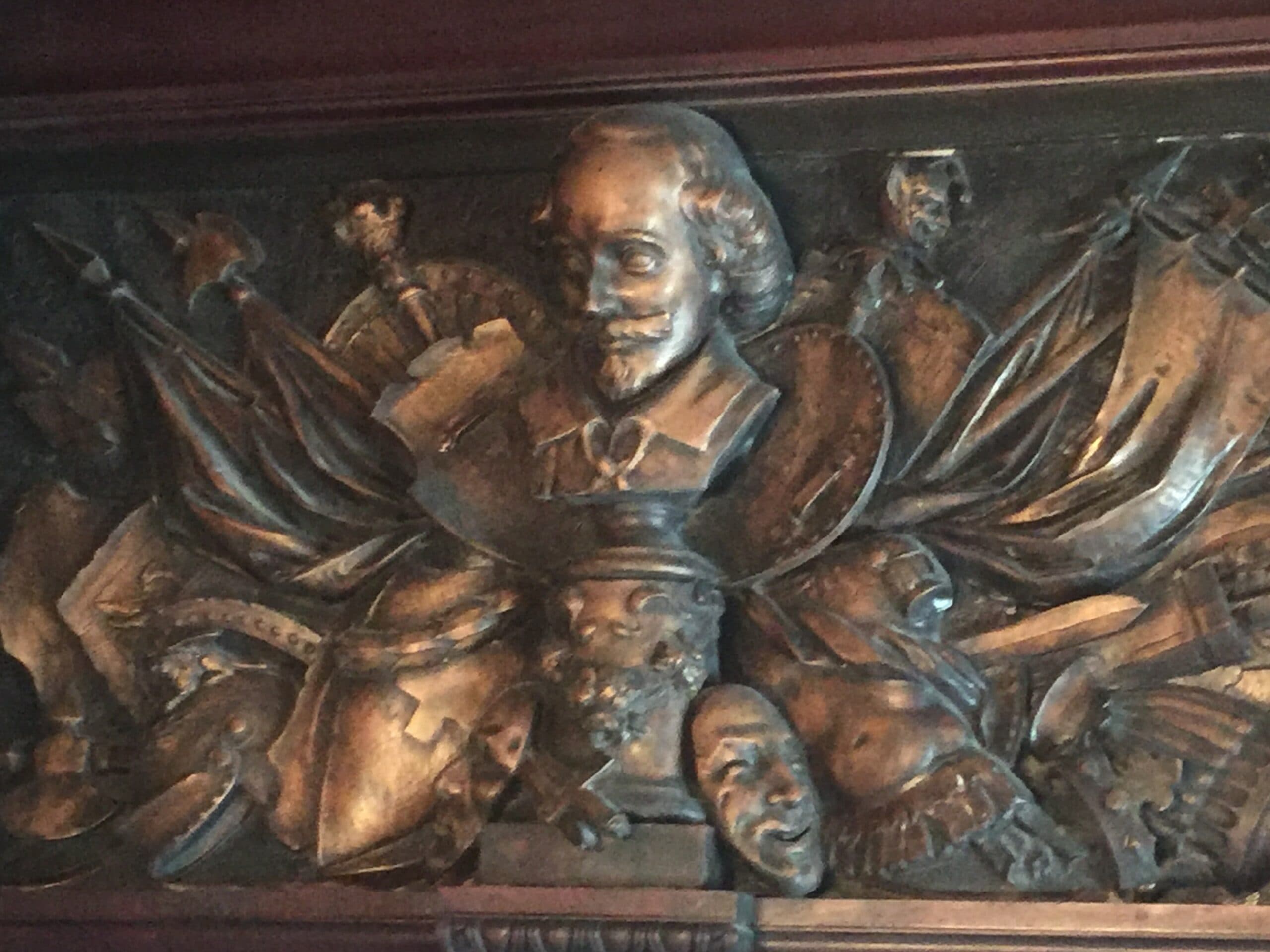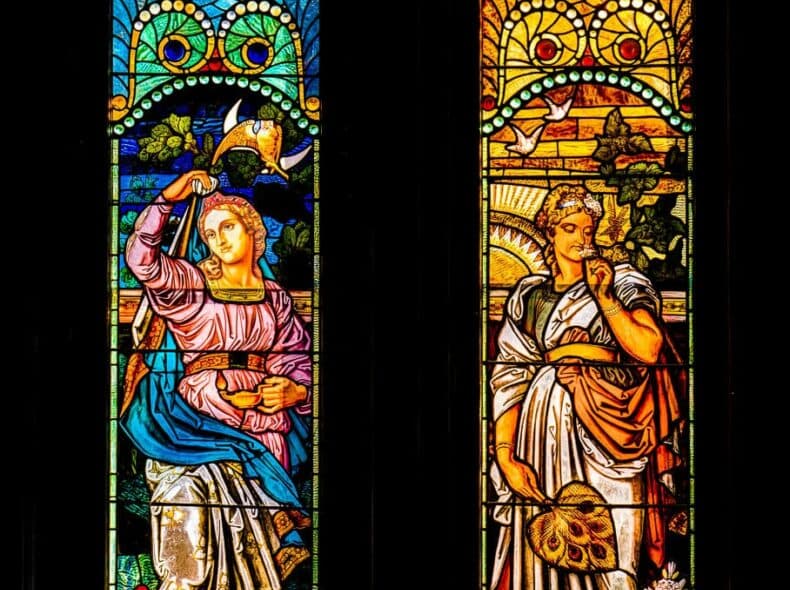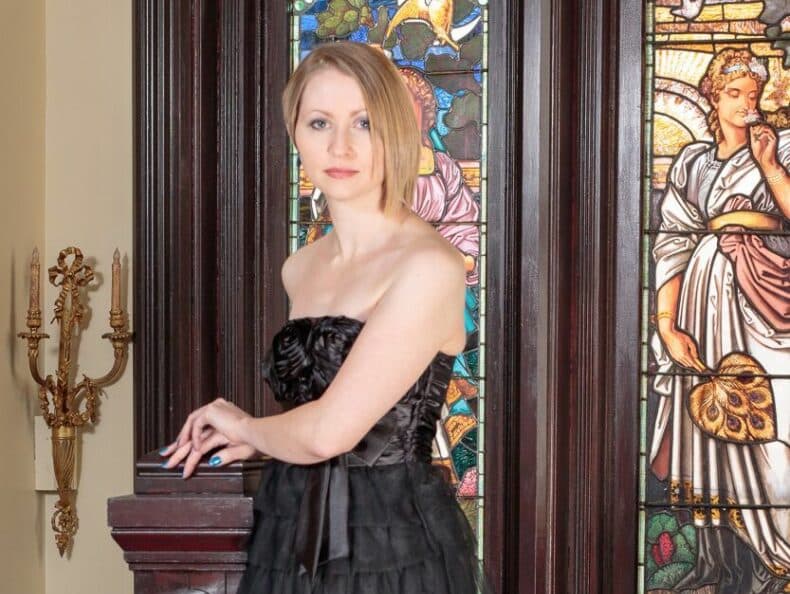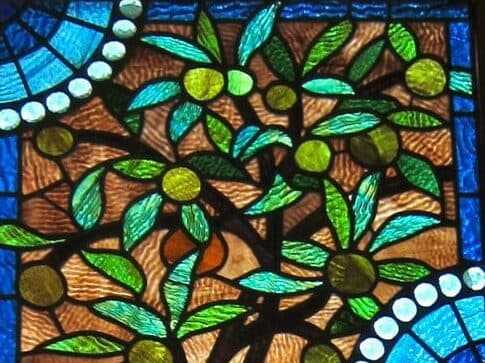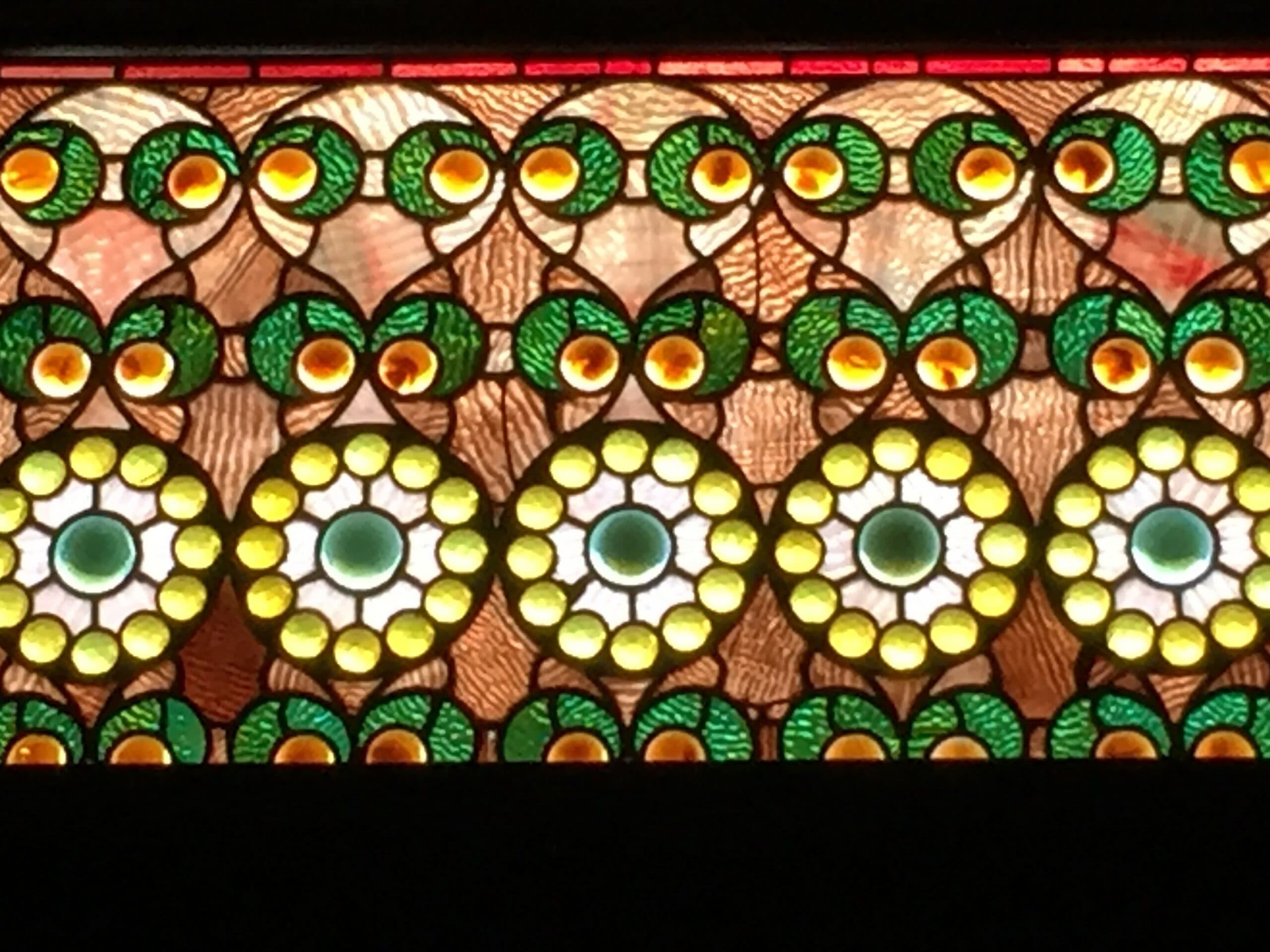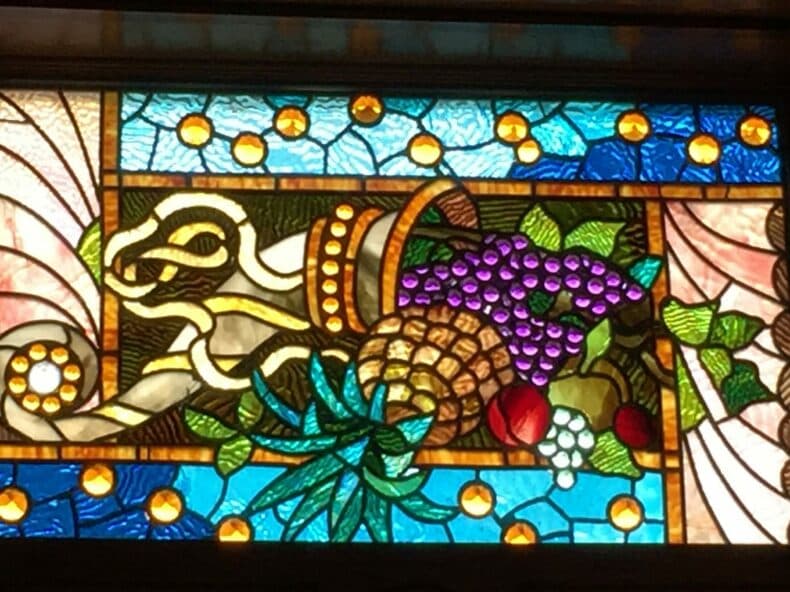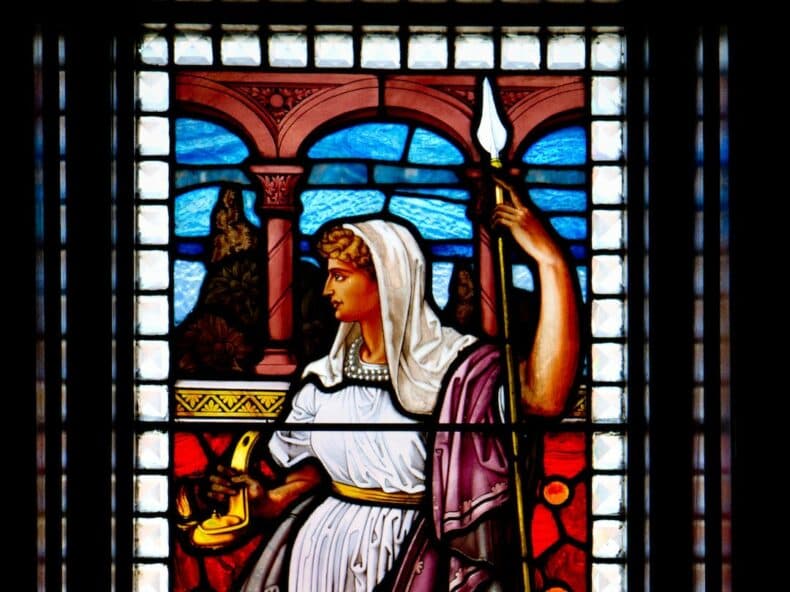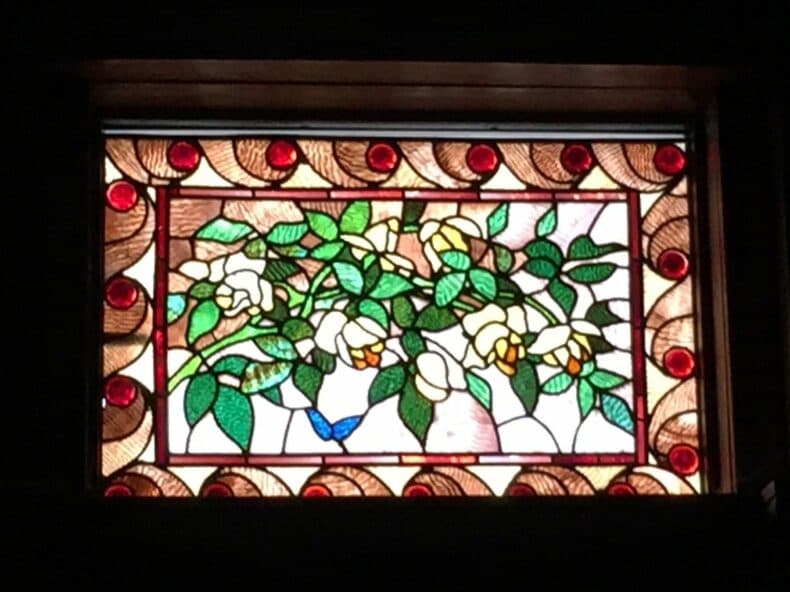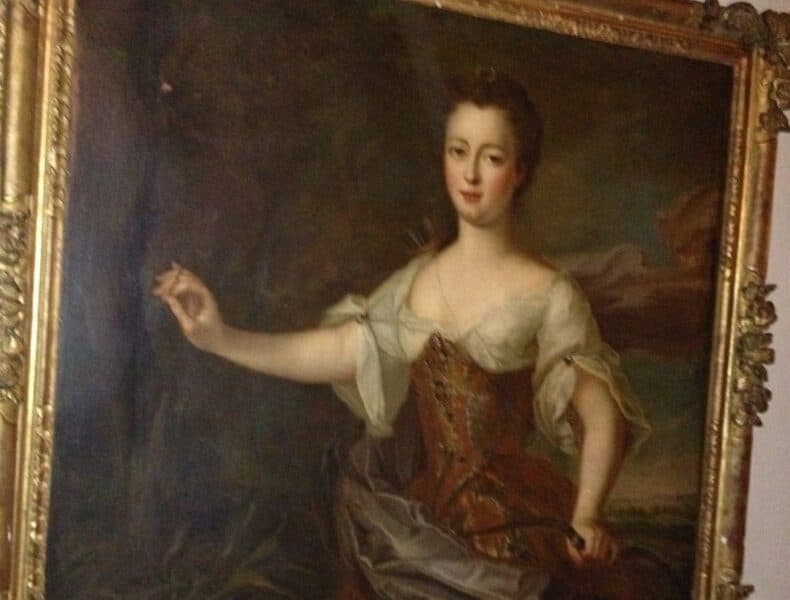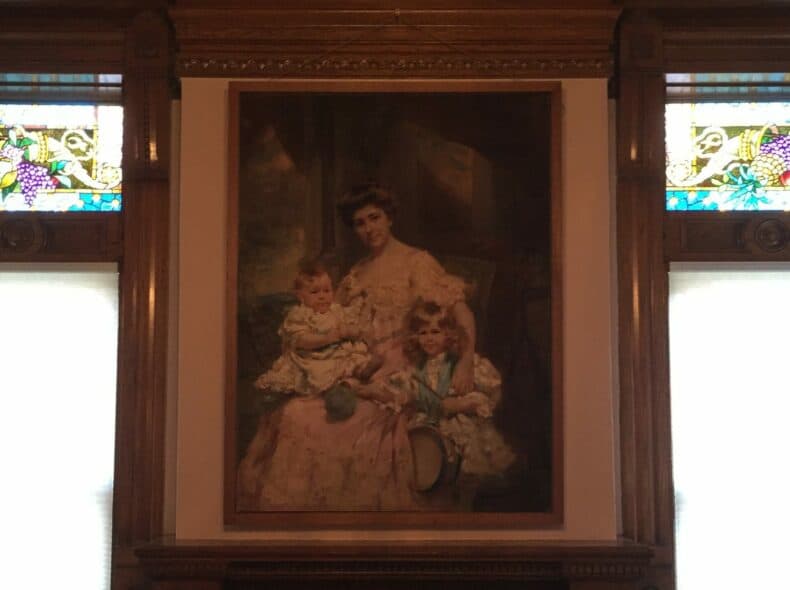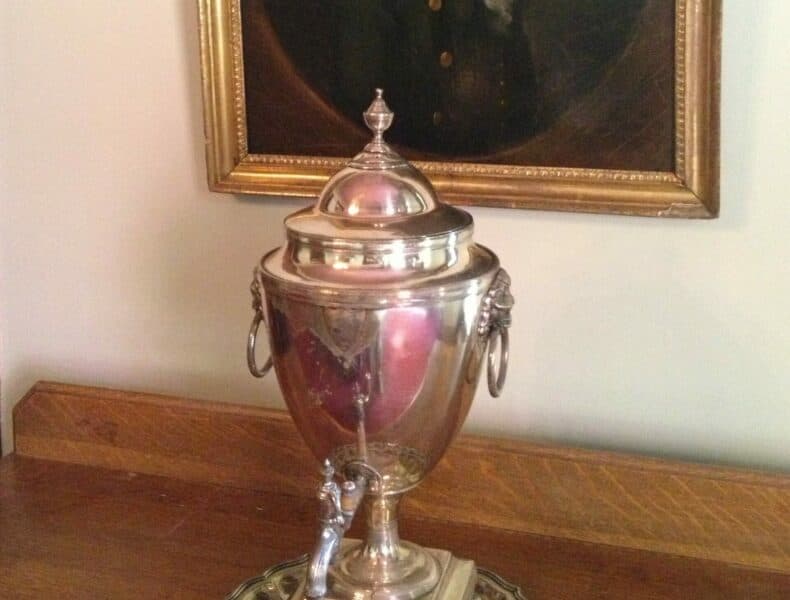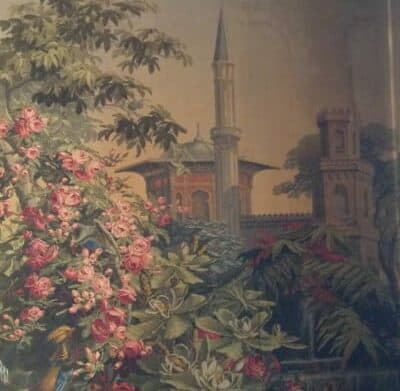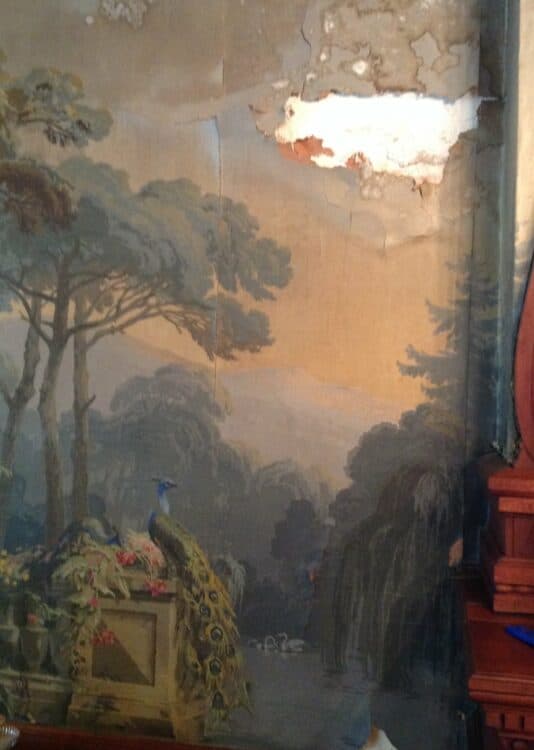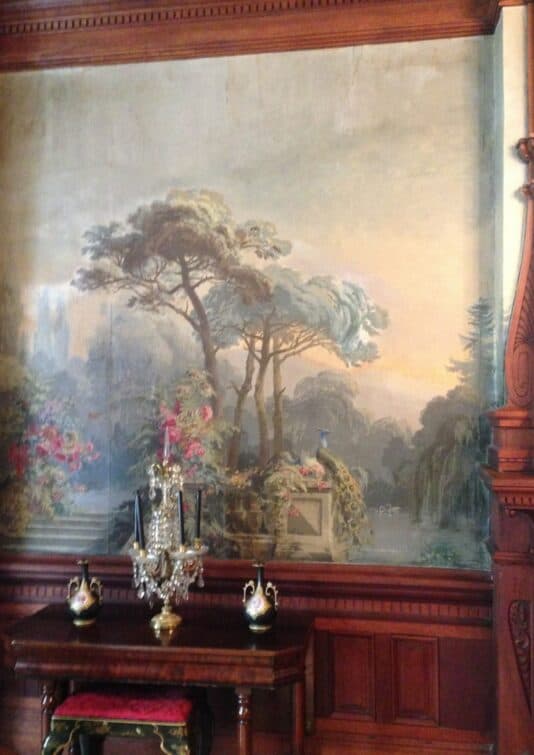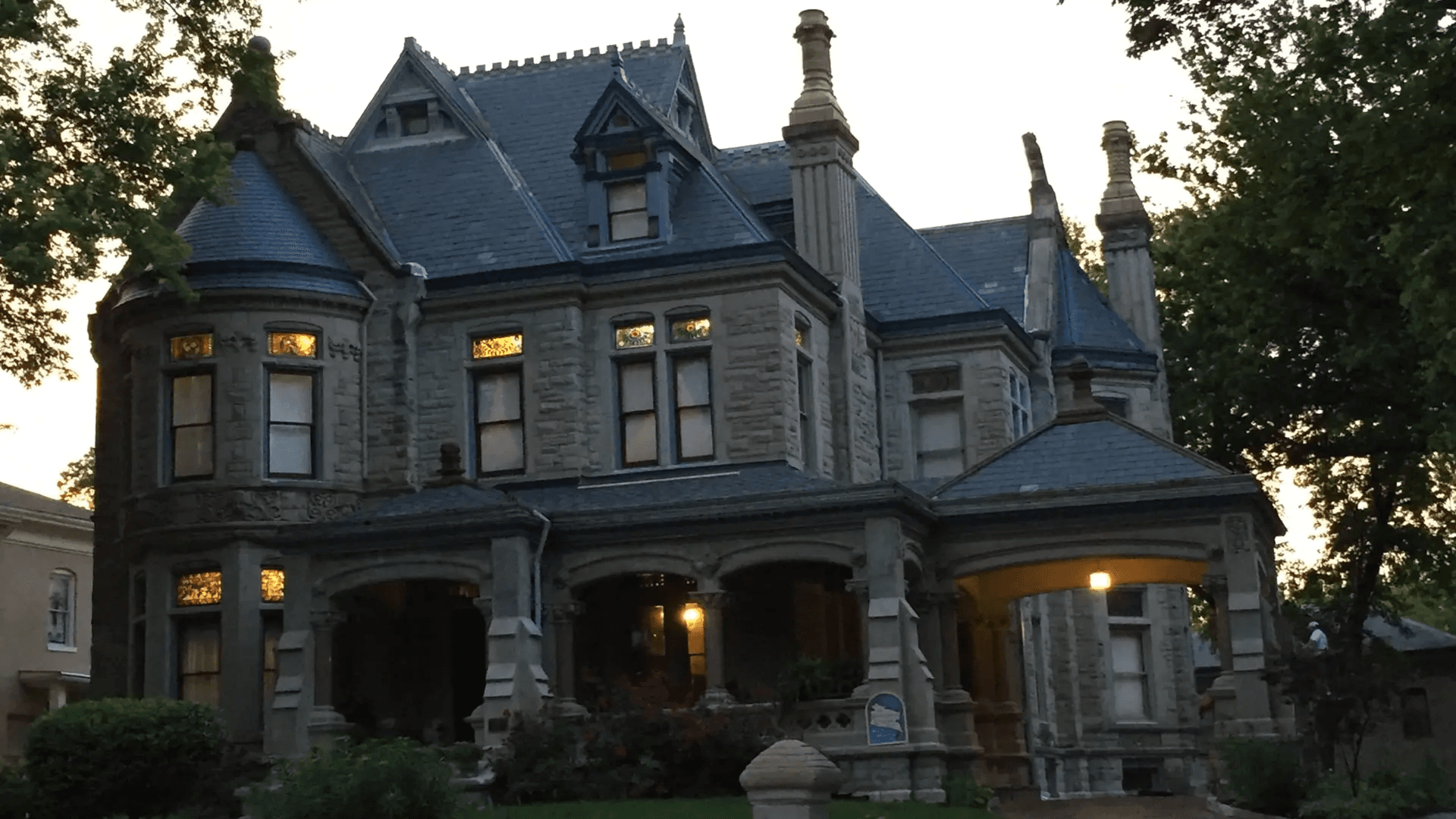
Tour Home Extraordinaire!
EXQUISITE ORIGINAL INTERIOR IN AN ARCHITECTURAL TREASURE
The majestic Shakespeare Chateau was built in 1885 for Nathan Phipps and Elmarine Ogden when St. Joseph was known as "Queen of the River Cities." High atop a bluff looking down across the city and the Missouri River, 809 Hall is one of several mansions in the National Register Historic District known locally as "Millionaires' Row."

St. Joseph's Premier Tour Home
The Shakespeare Chateau is a favorite tour destination, and has been a featured property on several successful home tours. In November 2012, the St. Joseph Symphony sponsored a Holiday Homes Tour that showcased the mansion lavishly decorated for the holidays, and the mansion has anchored several tours sponsored by Uptown St. Joseph Redevelopment. Most recently, the Shakespeare Chateau is home base for the "Jewels of St. Joseph" annual homes showcase to benefit the Historic St. Joseph Foundation.
Private Tours
Private tours are available for groups of 5 or more people, priced at just $10 per person. Enhanced private tours are also offered that include food and beverage options.
Call or email for enhanced tour pricing and reservation information.
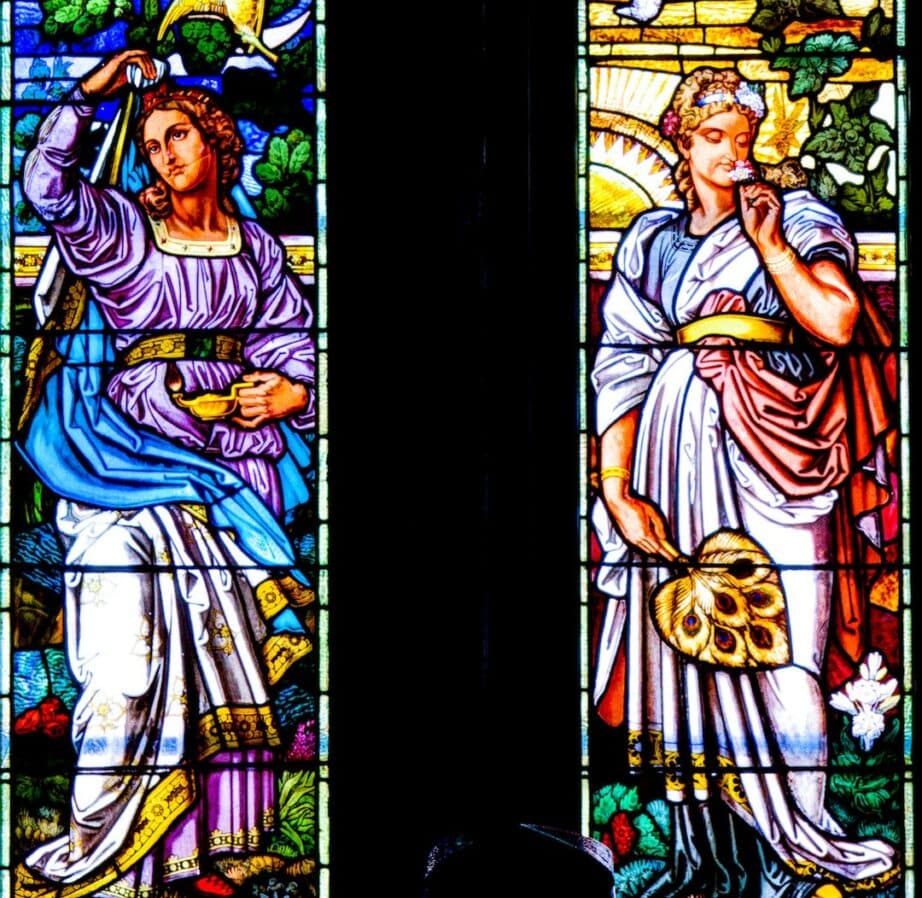
Stained Glass
AN EXTRAORDINARY COLLECTION
More than almost 140 years ago, Nathan and Elmarine Ogden built this chateauesque-style mansion on Hall Street, and appointed it lavishly with the best of everything that money could buy. Today, the Shakespeare Chateau still boasts 47 original artisan-crafted stained glass masterpieces. Photos can't do justice to the intricate designs and dazzling play of light through these windows.
After all those years of exposure to the elements and to the pull of gravity, many of the stained glass windows at the Shakespeare are in need of restoration. We have been taking them out a few at a time for full restoration, which includes cleaning and (in most cases) complete re-leading. The restored windows are protected with ventilated exterior clear lexan to prevent future damages. Come visit them in person to see the dramatic difference!
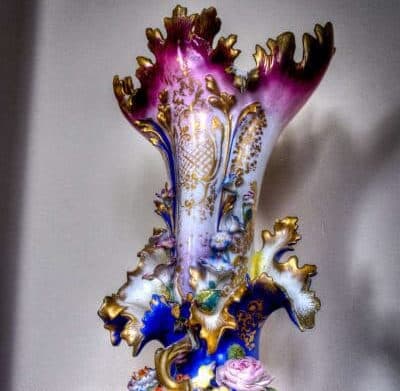
Art & Antiques
SEE OUR PRIVATE ART COLLECTION
The Shakespeare Chateau Inn & Gardens is home to an incomparable collection of paintings, sculpture, antique furniture, and accessories. Many of the pieces are of museum quality, and together represent a lifetime of collecting. Visitors to the Chateau love to view and discuss the fine art collection that is here.
Zuber Wallpaper
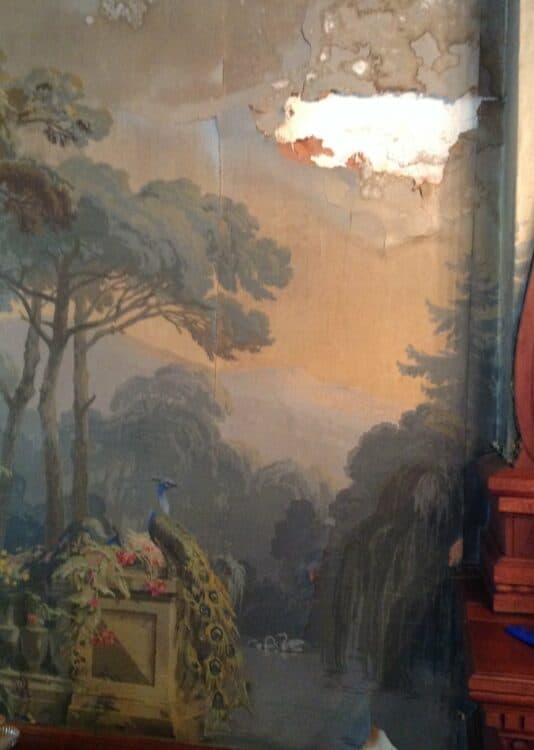
2012
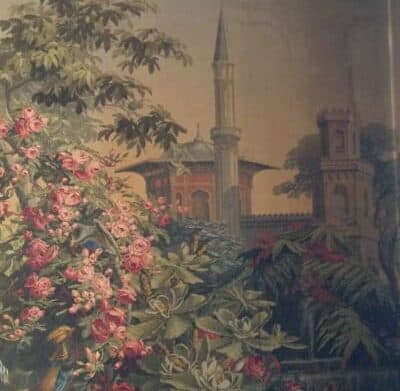
Restored
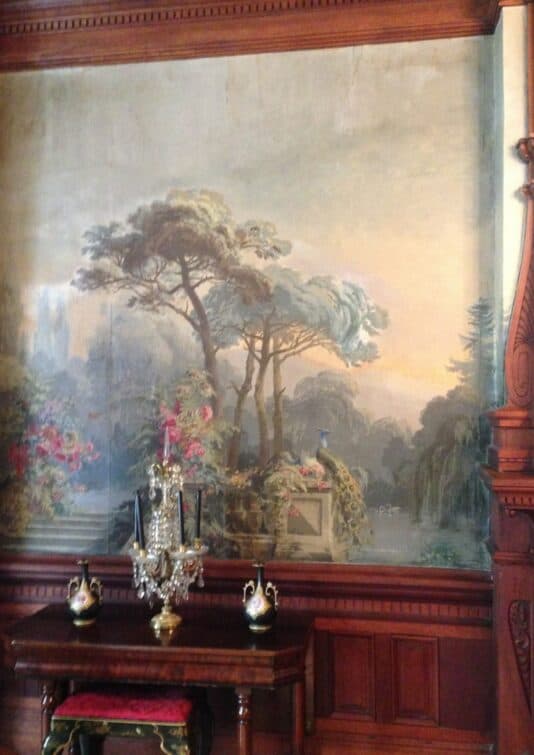
Restored
The Zuber Company of Rixheim, France has been making scenic (panoramic) wallpaper since 1797, the era of Naopoleon Bonaparte. One of the French national treasures, Zuber still has a showroom in Paris, France (and a few other select places, including New York City) where patrons can view and order their products. The wallpaper is printed using hand-carved wood-blocks selected from a library of over 100,000 such blocks featuring exquisite designs of foliage, flowers, monuments, birds, fountains, ruins, and more. Although it had been popular in Europe for over a century, Zuber wallpaper gained popularity with the moneyed class in America after the company was an exhibitor at the 1904 World's Fair in St. Louis, Missouri. So prized is this wallpaper that salvaged fragments are often framed and traded at upscale auction houses like Christie's and Sotheby's. During the "camelot" era of the 1960s, Jackie Kennedy had panoramic Zuber wallpaper installed at the White House, where it still hangs today. You can read more about Zuber wallpaper at their website, or read the Wikipedia entry under "Zuber et Cie." which references the Shakespeare Chateau. In-depth article about zuber wallpaper. May I suggest spending a worthwhile 10 minutes viewing this video at the Zuber website that offers an intimate view of the manufacturing process:
The Zuber scenic wallpaper at the Shakespeare Chateau was installed about 1920 by the second owners of the house, A.L. and Effie McPherson. The design, first printed in 1848, is called "Eldorado," and according to the Zuber website it uses 210 colors applied with 1554 separate wood blocks.
The colors and images are still bright and clear today after over 100 years, although the wallpaper now bears a patina of age. Over several periods in the past, it suffered from water damage that caused staining and some deterioration. In September 2014, we had a restoration completed that included securing loose and torn fragments, patching a section that was completely missing, and artistic coloration to match original. Plan a visit soon to view the extraordinary Zuber Parlor at the Shakespeare Chateau.
KNOW YOUR ANTIQUES By Ralph and Terry Kovel
The following newspaper article about Zuber wallpaper was published on November 26, 1961.
Q. The newspapers have been showing pictures of the newly decorated room at the White House. It has "historic Zuber wallpaper." Please explain.
A. Late in the 18th century "scenic" wallpaper became fashionable. The wallpaper pictured events of historic interest. The design did not repeat. The high ceilings and large rooms of the period made it possible to hang the large and colorful pictures.
Jean Zuber of Rixheim, Alsace-Lorraine, was one of the finest makers of scenic wallpapers. His factory first made wallpaper in 1790. The first large scenic "Views of Switzerland," was printed in 1803. The paper was colorful and interesting but the workmanship was crude.
His next scenic, "Views of the Mountains," appeared in 1825. The scenic "Scenes of Brazil," was printed in 1830.
Zuber printed the wallpapers but other artists designed them. The stone-drawn lithographs by Englemann made between 1825 and 1830 were the inspiration for the wallpaper called, "Scenic America," now hanging in the White House. Zipelius and Ehrmann designed the wallpaper.
The first of this paper was printed in 1834. It included pictures of West Point, New York, the Natural bridge of Virginia, Niagara Falls, and the dance of the Winnebago Indians. The paper makes a 48-foot panorama. The pattern was so popular that the paper was reprinted in 1851, 1854, and again in 1913. It has been issued many times since.
Zuber, delighted with the success of the paper re-designed it in 1838. He called it "The War of Independence." The background remained the same, but new figures were drawn in the foreground depicting the events of the Revolutionary war.
Other wallpapers by Zuber were "The Venetian Scenes," a misnamed set of pictures which includes a view of Rome, "Racing Tracks for Horses," "Isola Belle" printed in 1843 and "Eldorado" printed in 1848.
Zuber not only made paper with interesting pictures but was a pioneer in the development of methods of manufacturing wallpaper.
Zuber printed the first colored, continuous rolls of wallpaper in 1829. He installed the first cylinder color press in France in 1850.
The wallpaper usually was six feet in length. In many rooms it was necessary to place a wallpaper dado on the lower few feet of the wall. The papers were numbered and directions were included. They explained the manner in which the papers should be placed on a wall.
Zuber papers were always expensive. The wallpaper for an average room would have cost over $500 in 1824.
The paper for the White House was found hanging on the walls of a home in Thurmont, MD, last year by Peter Hill, a Washington lay preacher. The home was being torn down and Hill purchased the paper for $50 and took it off the walls with a razor blade. Hill sold the paper to the National Society of Interior Designers for $12,500. The society presented it to the White House.
Restoration
PRESERVING A LEGACY
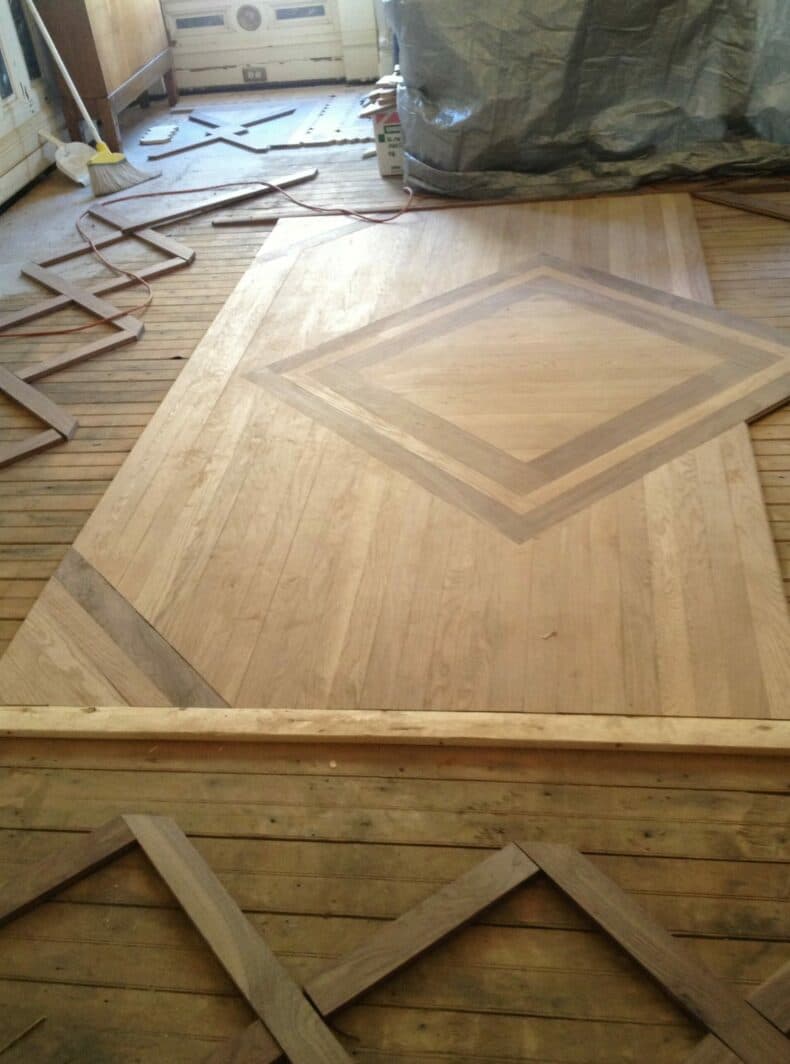
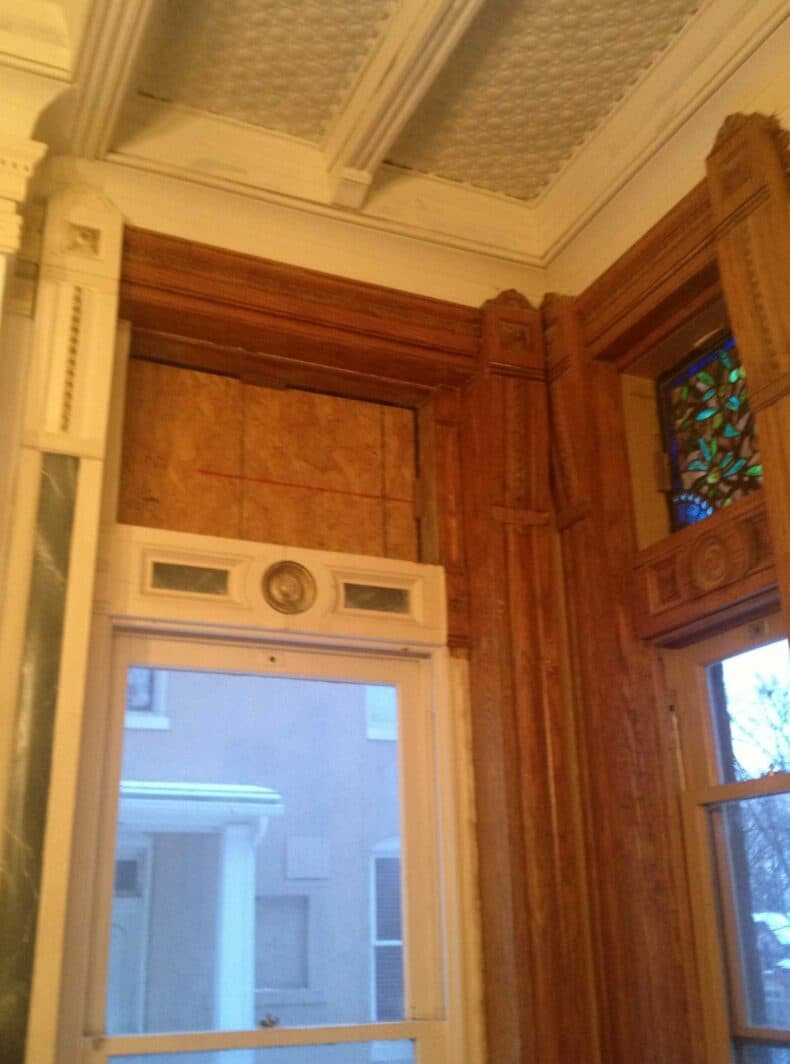

Here shown above, the faithful reproduction of the parquet floor in the dining room. The original floor suffered irreparable water damage during and following a pipe-burst episode several years ago. The floor has been re-laid to reproduce the original design using the same wood species (oak and walnut). Center, paint is stripped to reveal rich golden English oak woodwork. Finally, the newly finished floor and lovely woodwork (now stripped of paint) are gleaming and ready to welcome guests!

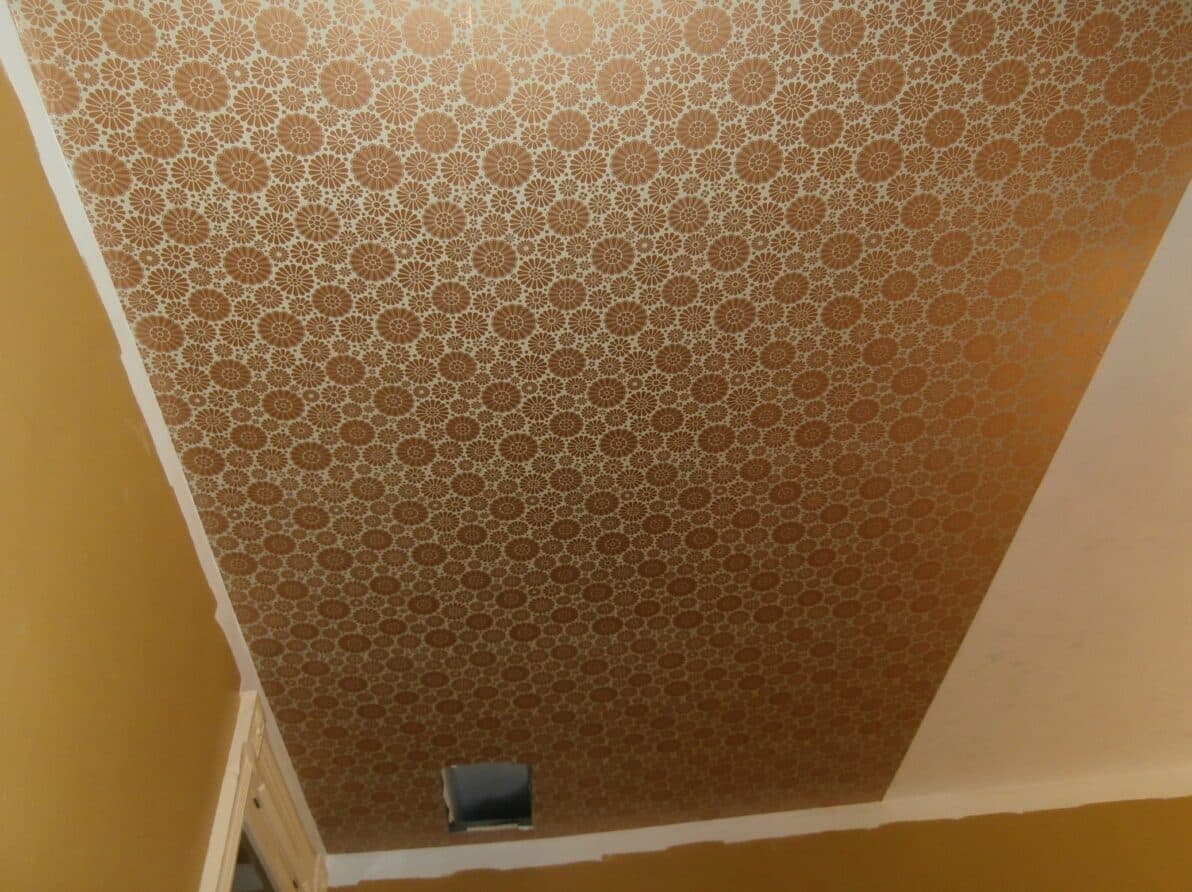
Installation of period-authentic hand-printed wallpaper from Bradbury and Bradbury on the ceiling in the Twelfth Night Room. Metallics add a rich luster to this pattern from Bradbury's "Centennial" room-set.


The kitchen was a disaster of peeling paint, heavy water damage, and a sagging floor.
The new kitchen was an epic undertaking, but now is an efficient and welcoming space for food preparation and for chatting with guests.
Please plan on visiting soon to see all of our on-going restoration projects!
Notable Guests
AUTHORS AND ARTISTS
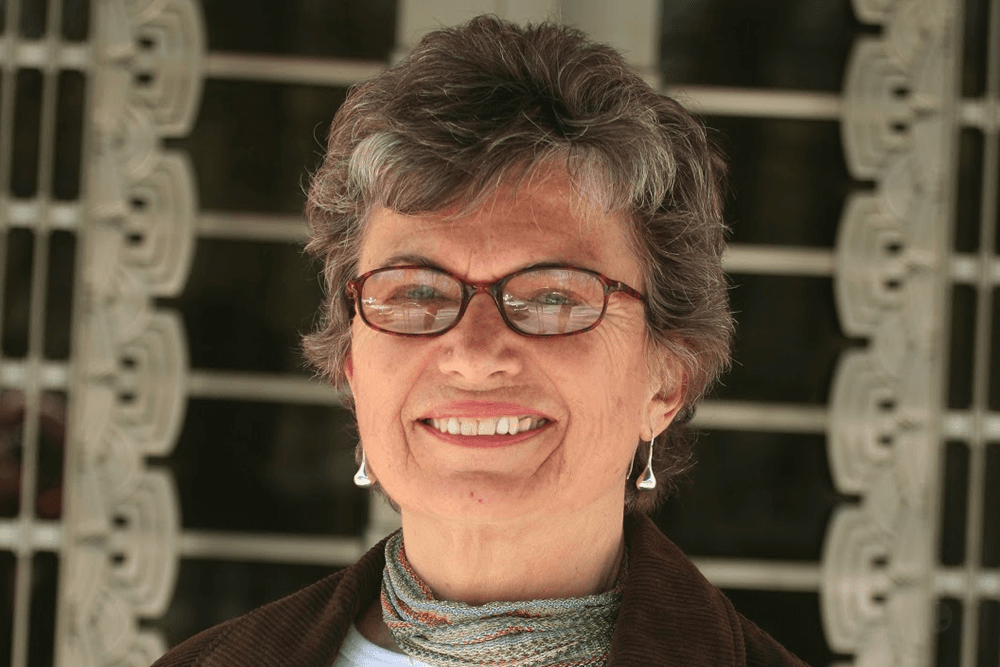
Roberta Brandes Gratz
Roberta Brandes Gratz is an award-winning journalist and urban critic, lecturer and author. One of her recent books is The Battle For Gotham: New York in the Shadow of Robert Moses and Jane Jacobs. Earlier works were the now classic The Living City: Thinking Small in a Big Way, and Cities Back from the Edge: New Life for Downtown. Ms. Gratz visited St. Joseph and the Shakespeare Chateau in June, 2013.

Doris Kearns Goodwin
Doris Kearns Goodwin is a Pulitzer-prize winning biographer, historian, and political commentator. She has authored several biographies of US Presidents, including Lyndon Johnson, John F. Kennedy, Franklin Roosevelt, Abraham Lincoln, Theodore Roosevelt, and William Howard Taft. Ms. Goodwin was invited to lecture at Missouri Western University and stayed at the Shakespeare Chateau in October, 2013.

Laurel Vartabedian
Laurel Vartabedian is an author, scriptwriter, and communication professor. Dr. Vartabedian currently lives in St. Joseph, Missouri, and is active in many aspects of community arts and life. One of her most recent successes is as scriptwriter of the critically acclaimed "Mother Divine" musical. Dr. Vartabedian has visited the Shakespeare Chateau on numerous occasions, and hosted several events here.

Caryl Bryer Fallert-Gentry
Caryl Bryer Fallert-Gentry is internationally recognized for her award-winning fine-art quilts, which have appeared in hundreds of national and international exhibitions, collections, and publications. Honors include 100 Best Quilts of the 20th Century, Silver Star (lifetime achievement) Award, and selection as one of the thirty most influential quiltmakers in the world. Caryl visited the Shakespeare Chateau in May 2013 and in May 2014.

David Sandy
David Sandy is an accomplished award-winning magician who has been entertaining professionally since the 1970s, including regular appearances in Las Vegas and at the Magic Castle in Hollywood, California. He has a unique ability to blend magic, comedy, and illusion into an entertaining program that engages and captivates the audience. His warm personality and superb showmanship make him a popular performer at any event. St. Joseph is fortunate that David lives right here in our community. He has performed at the Shakespeare Chateau on a number of occasions, and developed a show called "Magic and Mysteries at the Mansion."

Jamie McGuire
Jamie McGuire is an author of New Adult genre fiction, and has won critical and popular acclaim with her books Beautiful Disaster, Walking Disaster, and many others, and her works often appear on the New York Times, Wall Street Journal, and USA Today bestseller lists. Jamie visited the Shakespeare Chateau in October 2014 for a book-signing event.

Max Emanuel Cencic
Max Emanuel Cencic is an opera singer, recognized as having the finest countertenor voice of our day. He first became recognized as a member of the Vienna Boys' Choir before launching his solo career in 1992. He has performed at major opera houses and concert venues around the world, and has received many international awards. Mr Cencic visited the Shakespeare Chateau in January 2015.
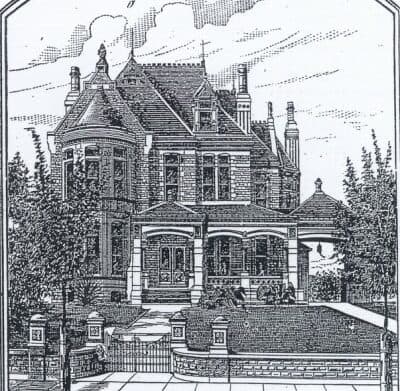
History Notes
BUILDER OF THE CHATEAU
The following article appeared in the St. Joseph Daily Herald on November 29, 1885. It describes the planing mill of Rufus Allen, who built the Shakespeare Chateau and many other mansions and public buildings in St. Joseph and the surrounding area. The article offers fascinating details about Mr Allen, and insight into the industry of home building in the late 19th century. The article also reveals that the cost to build the Shakespeare was $65,000!
OUR CITY INDUSTRIES
The Planing Mill of R.K.Allen, Contractor and Builder
Nos 206 and 208 North Second Street
One of the Most Important and Successful Enterprises in St. Joseph.
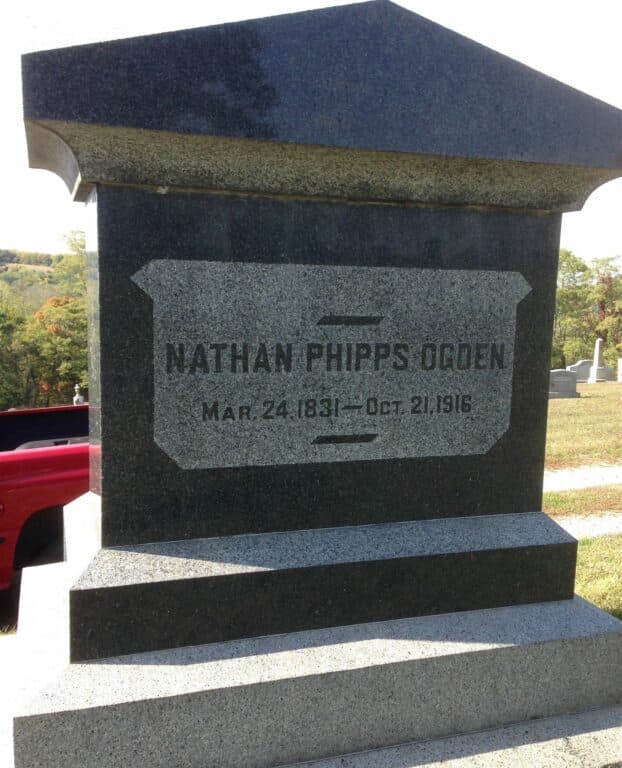
N.P. Ogden Obituary
Dateline 10/27/1916
Weston, Missouri
Col. Nathan Phipps Ogden formerly of Weston, pioneer, banker and capitalist of St. Joseph, died in that city Saturday night, after failing health of several months duration. He had been almost blind for the last three years and while he went but little he enjoyed the visits and calls from his many friends and acquaintances. He was born in Ohio eighty-six years ago, spent his boyhood in Pennsylvania. In 1857 he came by boat to Missouri, teaching school in Clay and Platte counties. During the Civil War he was a merchant at New Market where his store was raided by Quantrel's band. After this raid he removed the 'remainder of his stock' to Weston and continued business. He was a member of the Methodist church and remained active in that faith until death. During the erection of the present Methodist church in Weston he was one of the most generous donors. He received the title of colonel during the Civil war, as he was given command of a company of Platte county troops to cope with the invading bushwhackers.

St. Joseph Society 1888
St. Joseph Daily Gazette January 15, 1888
The Past Week's Events in Social Circles.
Reception to Mr. and Mrs. E.A. King at Col. Ogden's
On Thursday evening last the splendid residence of Mr. and Mrs. N.P. Ogden, 809 Hall Street, was thrown open for the reception of the many friends of Mr. and Mrs. E.A. King.

Night and Day
The two large stained glass panels, "Night" and "Morning" at the head of the stairway, lighted by numerous gas jets, looked more handsome than ever and drew forth the admiration of every guest.
The parlors, with the handsomely decorated walls and rich furnishings, the reception hall an elegant apartment, the music room, the library, the oriental room and the blue room, were all thrown open and shone with especial brilliance over the reception of the gay and more than happy throng.
The ladies on arrival were received in the rooms of Mr. and Mrs. King and Mr. Clarence King in his apartments took care of the gentlemen.
The dining-room was a fit place to make the epicure feel that during his life he had merely heard of the good things of life, yet had been unable to partake of them.
The furniture is of antique oak and the sideboard and mantels were banked high with the rarest cut flowers, and handsomely decorated with cut glass and silver. The center figure of the tables was a large ship decorated with beautiful flowers and so placed on a large mirror as to apparently float on the surface of a lake. There were flowers and fruits in profusion and the splendid supper prepared by Mrs. Sparks was the most elegant collation ever spread.
During the evening Prof. Winkler's full orchestra of ten pieces furnished beautiful music. The costumes worn by the ladies were handsome, all of them, many of which were made for the occasion.
Those present were:
Mr. and Mrs. C.F. Burns, Mr. and Mrs. J.M. Kemper, Mr. and Mrs. W.P. Jones, Mr. and Mrs. Geo. C. Hull, Mr. and Mrs. S.B. Green, Mr. and Mrs. Franklin Porter, Mr. and Mrs. D.M. Steele, Mr. and Mrs. J.W. Myers, Dr. and Mrs. T.H. Doyle, Mr. and Mrs. J.J. McDonald, Mr. and Mrs. J.D. Strong, Mr. and Mrs. Geo F. Hoagland, Mr. and Mrs. A.A. Gower, Mr. and Mrs. J.C. Forsee, Mr. and Mrs. J.D. Flint, Mr. and Mrs. R.U. Hendricks, Mr. and Mrs. J.C. Wyatt, Mr. and Mrs. R.S. Campbell, Mr. and Mrs. John Townsend, Mr. and Mrs. Dudley Smith, Mr. and Mrs. John Doniphan, Mr. and Mrs. James Hull, Mr. and Mrs. C.A. Shoup, Mr. and Mrs. Joshua Motter, Mr. and Mrs. W.W. Wheeler, Mr. and Mrs. W.P. Hall, Mr. and Mrs. A.B. Sowden, Mr. and Mrs. L.C. Burns, Mr. and Mrs. Byron Shoecrafts, Mrs. A.P. Welch, Dr. and Mrs. Banes, Dr. and Mrs. Runcie, Dr. and Mrs. W.I. Heddens, Mr. and Mrs. W.A.P. McDonald, Mr. and Mrs. W.F. McLean, Mr. and Mrs. M.A. Reed, Mr. and Mrs. J.K. Kercheval, Dr. and Mrs. A.H. Darby, Mr. and Mrs. S.M. Nave, Mr. and Mrs. J.G. Schnieder, Mr. and Mrs. E.S.F. Gatch, Mr. and Mrs. Geo. R. Mann, Mr. and Mrs. James Craig, Mr. and Mrs. B.R. Raeyard, Mr. and Mrs. Jos. P. Grubb, Mr. and Mrs. J.S. Lemon, Mr. and Mrs. A.E. McKinney, Dr. and Mrs. W.L. Heddens, Mrs. L.T. Ballinger, Mr. and Mrs. W.H. Gordon, Mr. and Mrs. Melvin Corby, Rev. and Mrs. William C. Brown, Mr. and Mrs. J.W. McAllister, Mr. and Mrs. R.L. McDonald, Mr. and Mrs. Hustin Wyeth, Mr. and Mrs. S.A. Walker, Dr. and Mrs. W.C. Boteler, Dr. and Mrs. R.E. Smith, Mr. and Mrs. Jno. Donivan, Sr., Mr. and Mrs. R.D. Gilkey, Mrs. I. Rogers, Mr. and Mrs. C.B. France, Mr. and Mrs. E. Lindsay, Mr. and Mrs. C.D. Smith, Mr. and Mrs. J.T. Ransom, Colonel and Mrs. A.N. Schuster, Mr. and Mrs. J.W. Hingston, Mr. and Mrs. F.B. Hooper, Mr. A. Kirkpatrick, Mrs. Sarah Gallaher, Mr. W.T. Hosea, Mr. F. Smith, Mr. and Mrs. T.M. Haynes, Mr. and Mrs. Louis Motter, Mr. and Mrs. Winslow __dson, Dr. and Mrs. Joseph Malin, Dr. and Mrs. H.W. Westover, Mr. and Mrs. E.L. ¬¬__rney, Mr. and Mrs. G.G. Parry, Mr. and Mrs. E.W. Ray, Dr. and Mrs. John S. Logan, Mr. and Mrs. H.M. Tootle, Mr. and Mrs. C.B. ___aders, Colonel and Mrs. A.C. Dawes, Mr. and Mrs. C.L. Vandeventer, Mr. and Mrs. J. Evans, Mr. and Mrs. H.A. Hansen, Mr. and Mrs. T.F. Indermill, Mr. and Mrs. H. Perry, Mr. and Mrs. Samuel L. Smith, Mr. and Mrs. W.D.R. Motter, Mr. and Mrs. Martin, Dr. and Mrs. Knight, Mrs. E.M. Wallingford, Mrs. Susan Smith, Major and Mrs. J.F. Johnson, Mr. and Mrs. P. Pattison, Mr. and Mrs. F.M. Tufts, Mr. and Mrs. W.F. Merrill, Dr. and Mrs. H. Gar___, Mrs. E.R. Inslee, Mr. and Mrs. Geo. W. ___low, Mr. and Mrs. C.M. Edwards, Mr. and Mrs. A. Nave, Mr. and Mrs. N.J. Riley, Mr. and Mrs. C.A. Tawney, Mr. and Mrs. H. George, Mr. and Mrs. Hilton, Mr. and Mrs. U. Buell, Mr. and Mrs. R.J. Woodson, Mr. and Mrs. A.L. Kerr, Mr. and Mrs. S. Wood___, Mrs. Eilen Frame, Major and Mrs. S.A. ___sh, Mr. and Mrs. D.C. Lyon, Mr. and Mrs. Englehart, Elder and Mrs. M.M. Goode, Mr. and Mrs. J.S. Brittain, Mr. and Mrs. A. Smith, Mr. and Mrs. Ed Van ____y, Mr. and Mrs. T.H. El___, Mr. and Mrs. Louis Hax, Jr., Mr. and Mrs. J.A. Corby, Mr. and Mrs. W.G. ___eigh, Mr. and Mrs. E.E. McCammon, Mr. and Mrs. R.W. Todd, Mr. and Mrs. T.E. Campbell, Mr. and Mrs. W. Calhoun, Mr. and Mrs. S.C. Woodson, Mr. and Mrs. Geo. I. ___mer, Mr. and Mrs. R.R. Calkins, Mr. and Mrs. H.A. Smith, Mr. and Mrs. C.S. Kemper, Mr. and Mrs. T.N. Trice, Mr. and Mrs. T.F. ___tts, Mr. and Mrs. S.R. Greer, Mr. and Mrs. J.N. Burns, Mr. and Mrs. A.M. Dough___, Mr. and Mrs. M. Lincoln, Mr. and Mrs. __ Lacy, Mr. and Mrs. John McCord, Mr. and Mrs. Eugene Soper, Mr. and Mrs. W.F. McDonald, Mr. and Mrs. M.R. Jones, Mr. and Mrs. T.F. Tootle, Mr. and Mrs. Wm. Jones, Mr. and Mrs. I. Well, Mr. and Mrs. Kunt, R.E. Loan, Mrs. Van Riley, Mrs. Laura ¬¬¬___er, Mrs. G.E.F. Burton, Mrs. S.S. Vance, ¬¬___ Westley, Mrs. Helen Kircheval, Mr. and Mrs. Shrader, Mr. and Mrs. J.S. Thorpe, Mr. and Mrs. James Kay, Mr. and Mrs. J.D. ___deon, Jr., Mr. and Mrs. T.K. Wilson, Mr. and Mrs. F.R. Snyder, Mr. and Mrs. S. McDonald, Mr. and Mrs. S.N. Smith, Mr. and Mrs. T.P. Maupin, Mr. and Mrs. M.S. Nor___, Mr. and Mrs. J.S. Johnson, Mr. and Mrs. W.C. Sipple, Mr. and Mrs. R.T. Davis, Mr. and Mrs. R.L. Beaumont, Mr. and Mrs. ___ Collins, Mr. and Mrs. T.A. ___ler, Mr. and Mrs. R.C. Rogers, Mr. and Mrs. Ashmale, Leavenworth, Mr. and Mrs. J.W. Moore, San Antonio, Tex., Mr. and Mrs. J.W. Alexander, Gallatin, Mr. and Mrs. J.M. Railey, Mr. and Mrs. E.W. Railey, Miss Emma Railey, Miss Bette Railey, Mr. and Mrs. D.M. Railey, Mr. and Mrs. J. Hardesty, Mr. and Mrs. L.M. Wells, Miss Elvira Wells, Mr. and Mrs. O.D. Guthrie, Mr. and Mrs. R. Jacquemin, Weston, Mo., Mr. and Mrs. J.H. Waugh, Columbia, Mr. and Mrs. W.C. Wells, Platte City, Judge T.H. Talbott, Platte City, Mrs. Matie Sawyer, Leavenworth, Lieut. And Mrs. S. Wolf, Ft. Spokane, W.T., Mr. and Mrs. C.J. White, Mr. and Mrs. R.S. Adkins, Mr. and Mrs. J.G. Adkins, Mr. and Mrs. Jas. Gibson, Mrs. Emma Vinyard, Mr. and Mrs. D.H. Winton, Mr. and Mrs. A.T. Ball, Mr. and Mrs. George C. Smith, Mr. and Mrs. W. McFarland, Mr. and Mrs. W.A. Wilson, Mr. and Mrs. R.W. Hocker, Miss Mary Leach, Miss Anna Buck, Kansas City, Mr. and Mrs. M.R. Singleton, Mr. and Mrs. J.B. Kitchen, Omaha, Lieutenant and Mrs. L. Craig, Mr. and Mrs. J.G. French, Mr. and Mrs. J.P. Hicks, Mr. and Mrs. Charles Warner, Mr. and Mrs. V.N. Crandall, St. Louis, Dr. and Mrs. B.R. Fakes, Miss Rena Slayden, Ocola, Fla., Mr. S.W. Slayden, Mr. and Mrs. J.E. Mayo, Waco, Texas, Mr. and Mrs. Fakes, Ft. Worth, Texas, Mr. and Mrs. J.T. Litchfield, Mr. and Mrs. Robert Robertson, Miss Emma Reed, Liberty, Neb., Mr. and Mrs. Donald, W.T.F. Donald, Mr. and Mrs. W.F. Donald, Mr. and Mrs. J. Donald, Miss Susie Donald, Mr. and Mrs. J.G. Greenwalk, Dr. and Mrs. Charles, General and Mrs. W.W. Gustine, Atchison, Kansas, Misses McDonald, Vernon, McKinney Ballinger, Burns, McCord, Brittain, Buck, Kansas City, Ely, Welch, Shultz, Hilton, Ketcham, Lincoln, Buell, Smith, Lulu Smith, Fessenden, Hawks, Curtis, Tuft, Perry, Goode, Turner, Burton, Furguson, Ridenbaugh, Edwards, Dougherty, Smith, Kerr, Constable Relchard, Bassett, Hughes, Forsythe, White, Parker, Wells, King, Howe, Schuster, messrs. R.E. Turner, G.W. Samuels, A.M. Saxton, Thomas Frazier, John Anthony, Arch Gracie, Joe Moss, James Corby, Frank Smith, Herbert Coulter, E.E. Phelps, J.F. Pitt, John Brady, Joe Roberts, Alex McDonald, Ed Smith, Chas. France, Robert France, Lee Gallagher, John Burns, Jr., D.D. Burns, O.M. Spencer, P. Bassett, James Davison, George C. Smith, Charles Berry, Charles Kessler, Richard Kessler, Thomas Heddens, Robert McDoanld, Ed Edwards, Bates Weakly, Lol Weakly, Father Newman, Father Graham, Samuel S. McCord, John McNair, Edson Gregg, E.S. Douglas, Russell Douglas, A.H. Hoffman, J.W. Kimball, George Cooke, Charles Weihl, John Trice.
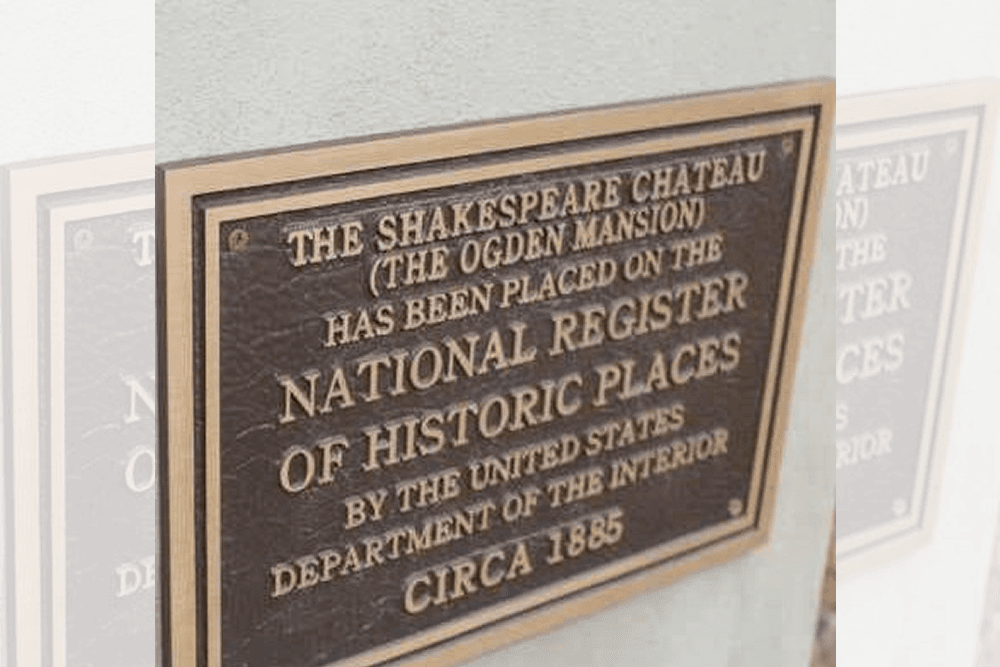
Transcription Notes
Mr. and Mrs. E.A.King, for whom Colonel Nathan Ogden and his wife Elmarine Pence Ogden held the reception, were the son (Edward) and daughter-in-law of Elmarine. Elmarine had been previously married in 1859 to King, and had two sons, Edward and Clarence. She was divorced from King when she married Ogden in 1879. Nathan and Elmarine moved to St. Joseph from Weston in 1880, and by 1885 the mansion at 809 Hall Street was finished. Elmarine passed away in 1899, and Nathan re-married the following year in 1900 to Jesse Donald Ashmun. Nathan died in 1916.
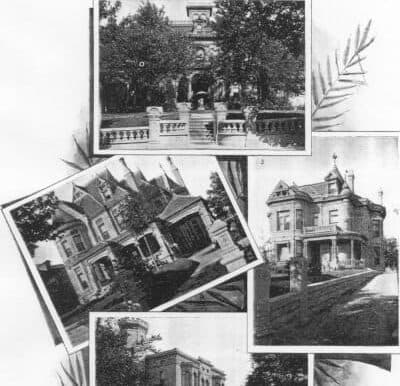
Preservation Philosophy
"As a nation, we have allowed too much of our heritage - the places and objects that comprise the collective memory of America - to deteriorate. These remnants of our past could, if protected, illuminate and inspire future generations. Their preservation is our sacred trust."
From "Saving America's Treasures" Foreword by Hilary Rodham Clinton
"We must welcome the future, remembering that soon it will be the past; and we must respect the past, remembering that it was once all that was humanly possible."
George Santayana
Drone Video of the Inn, shot in August 2015
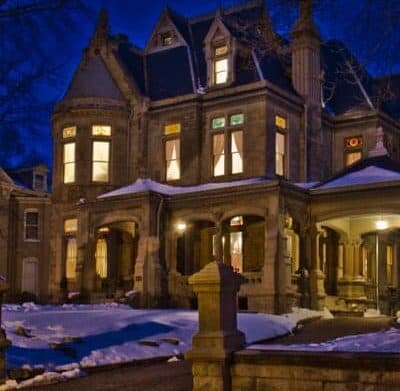
Symbols and Symbology at the Shakespeare Chateau
Many symbols are reflected in the interior and exterior design elements of the Shakespeare Chateau, including the stained glass, carved stone decorations, and interior woodwork. The more noticeable symbolic features are listed here, although many more designs may have significance that has so far escaped me! As you look over the list, you'll note that symbols of transformation and rebirth are prevalent. I have spoken often of the transformation of the building and on Hall Street that has taken place under my ownership, and of the transformation I have experienced in myself as I created the asset that is the Shakespeare Chateau. Transformation is the concept and the motivator that has kept me engaged here, and can also be a guiding principle of future undertakings, including education as a transformative experience for people, and preservation as a transformative experience for our community.
William Shakespeare - bronzed bust above the grand mantle.

Lemon Curd
This delicious buttery lemon sauce is made with just four simple ingredients. It is perfect with warm scones, spread on toast or English muffins, or used as a filling for cakes and tarts.
This recipe yields about 2 cups.

